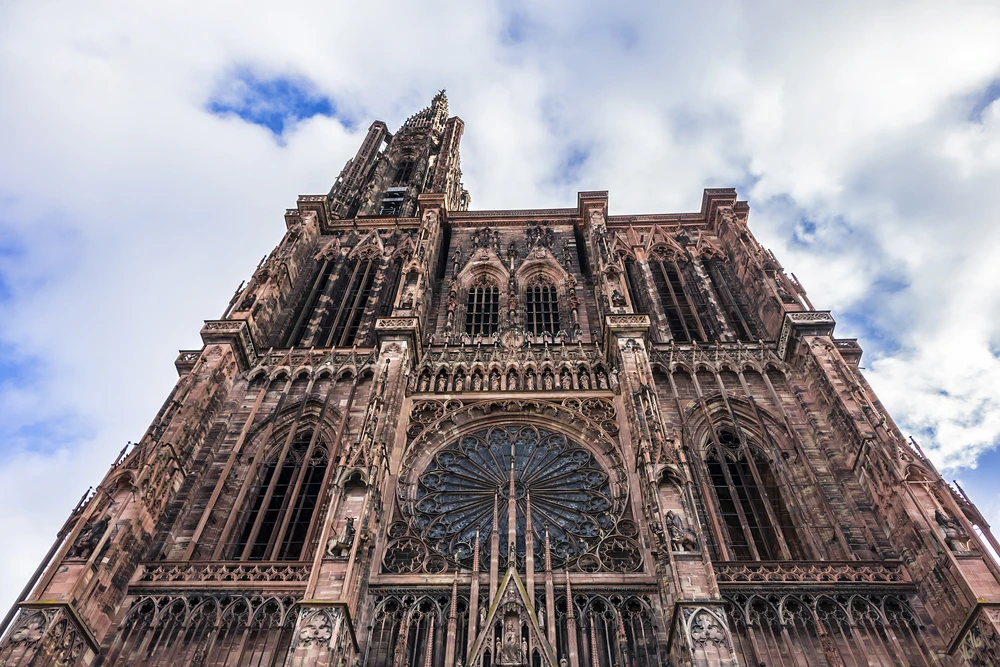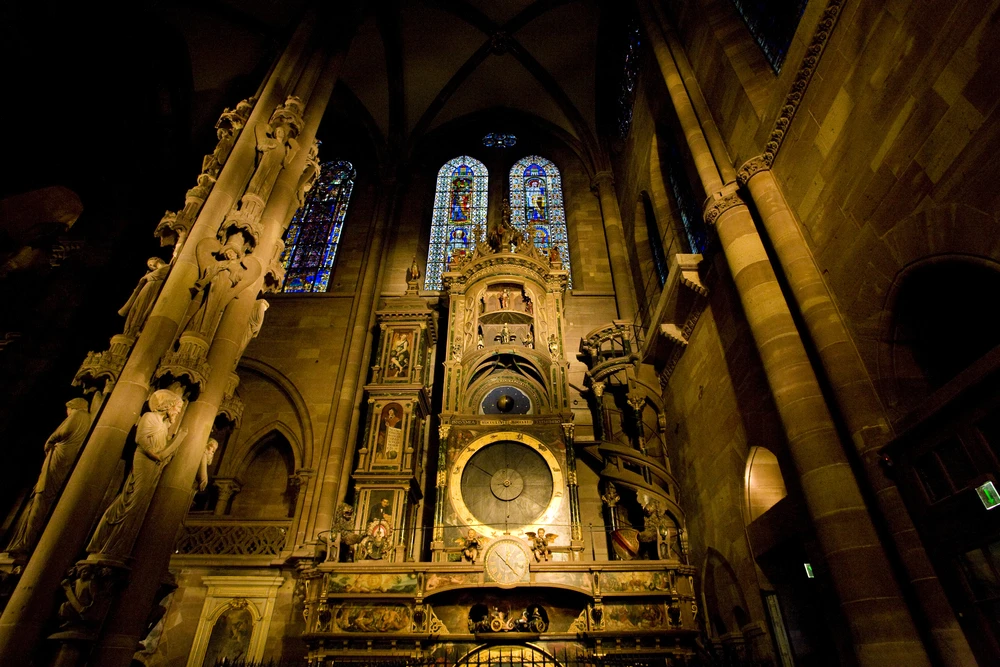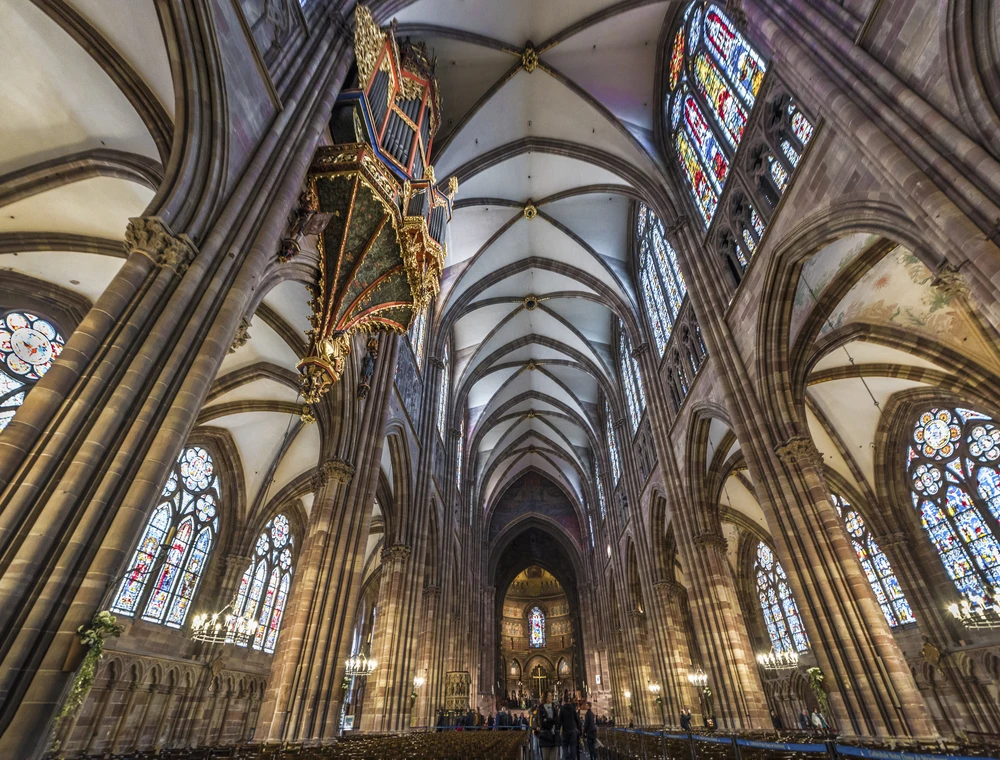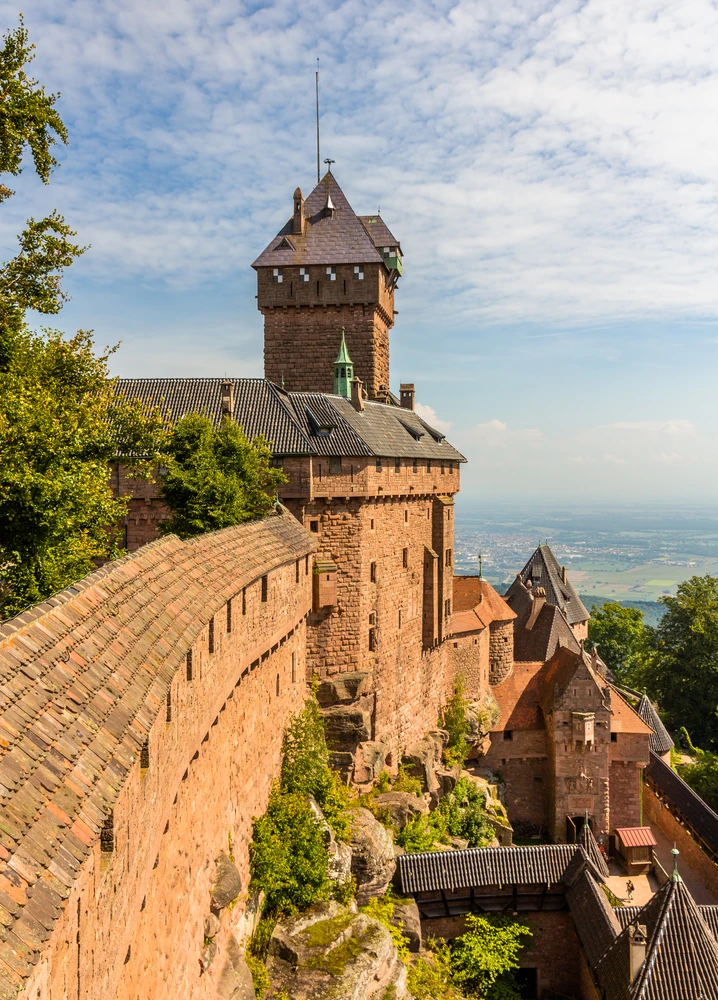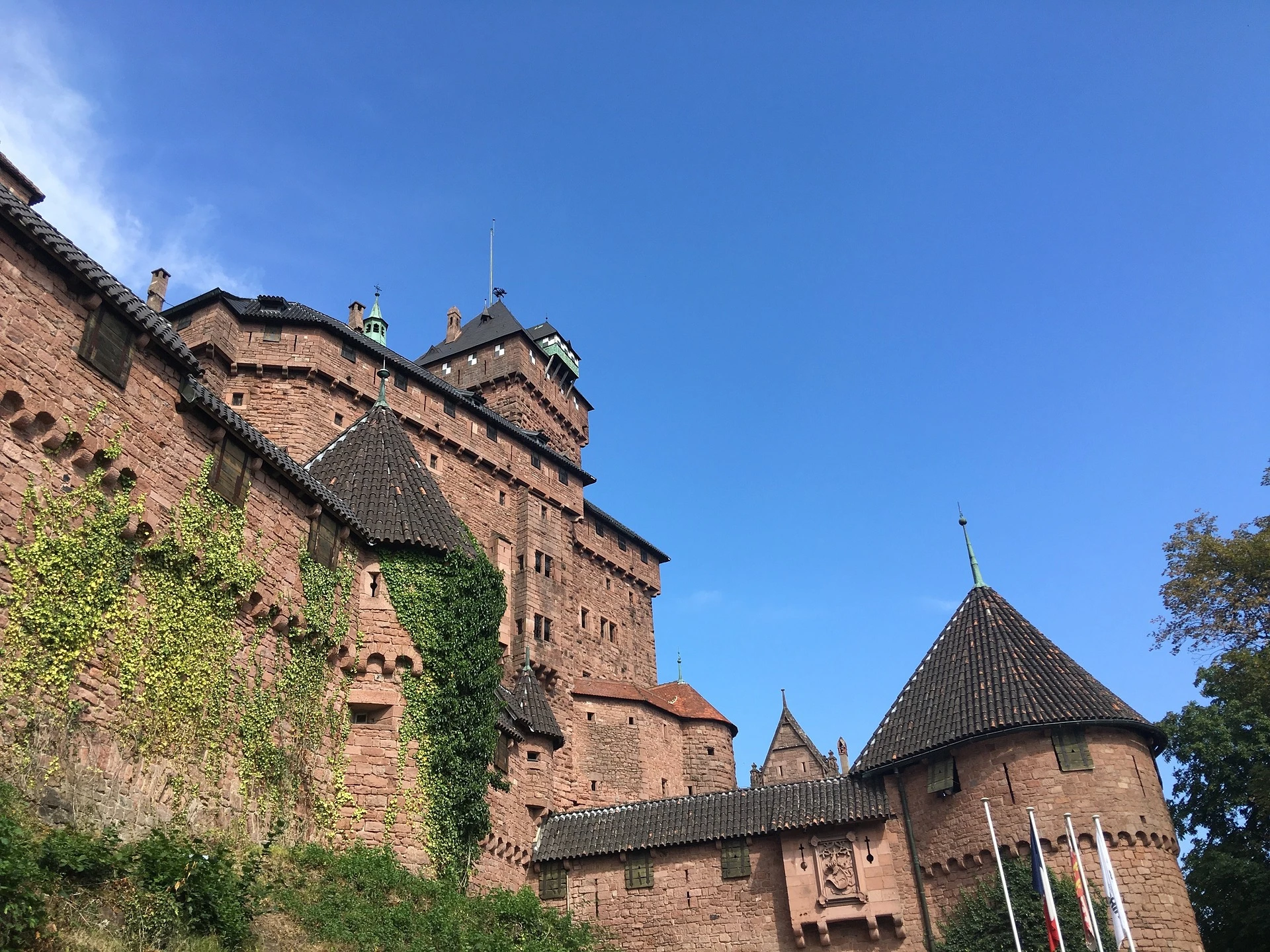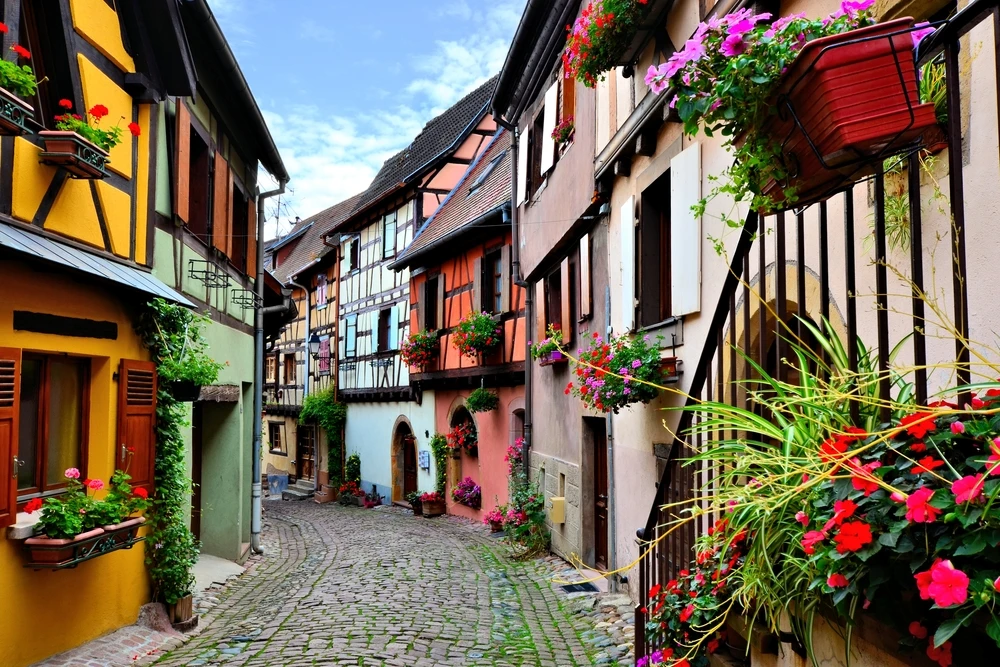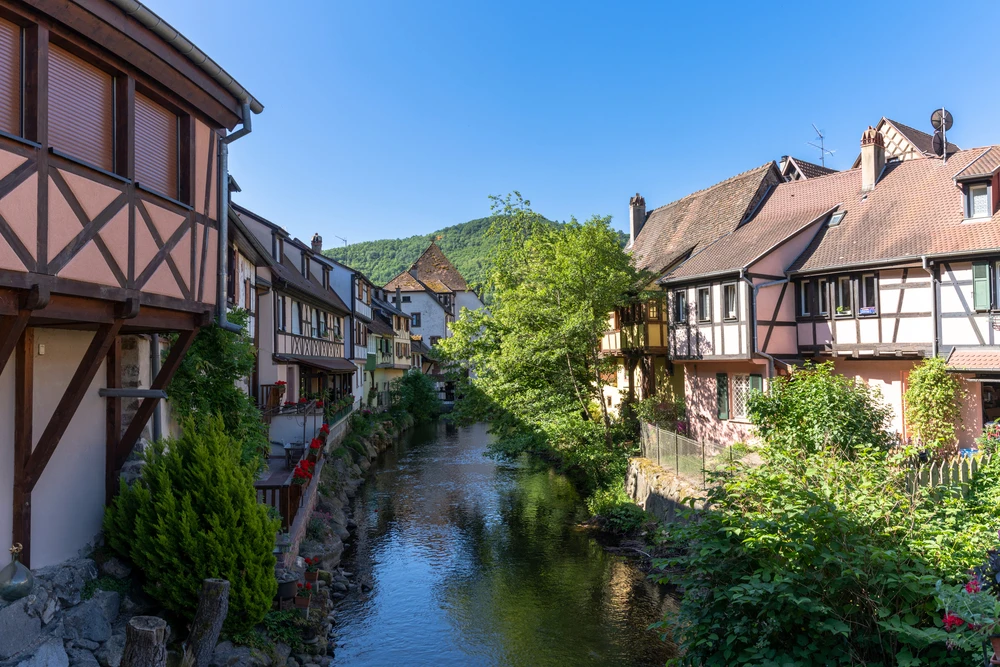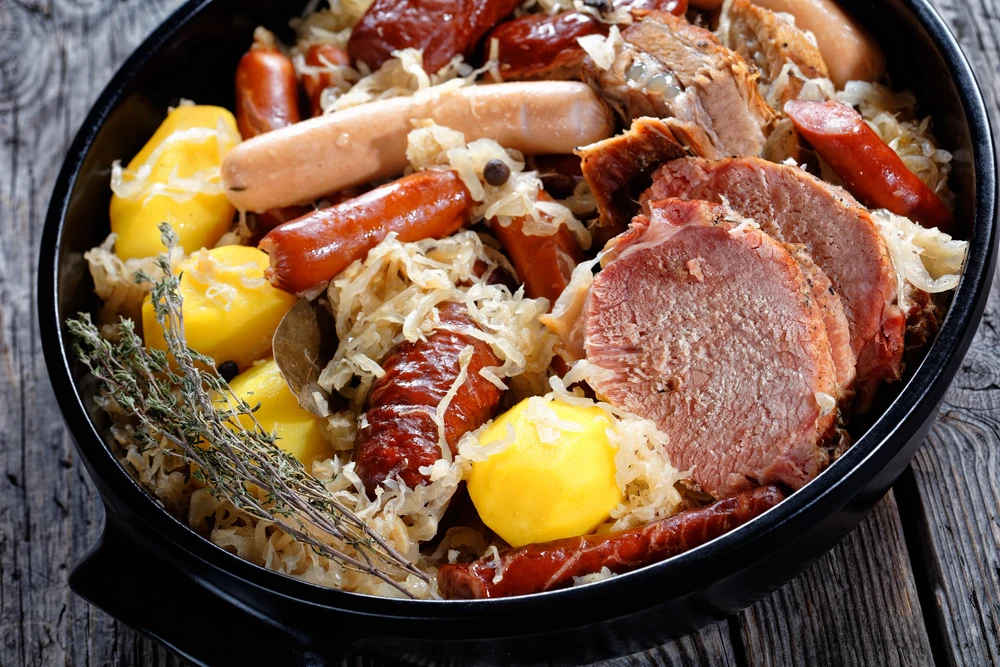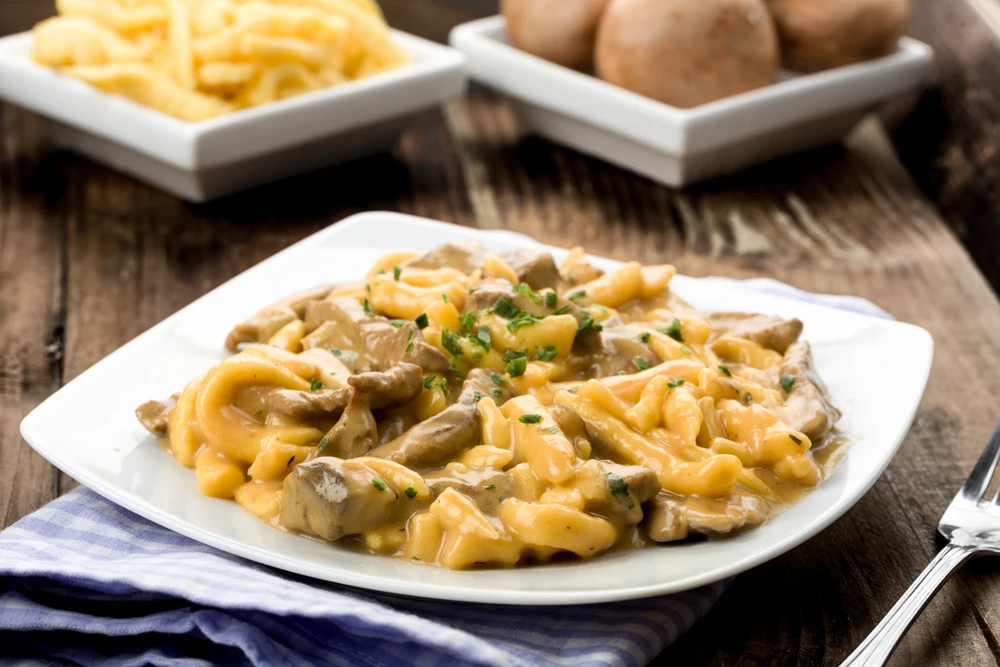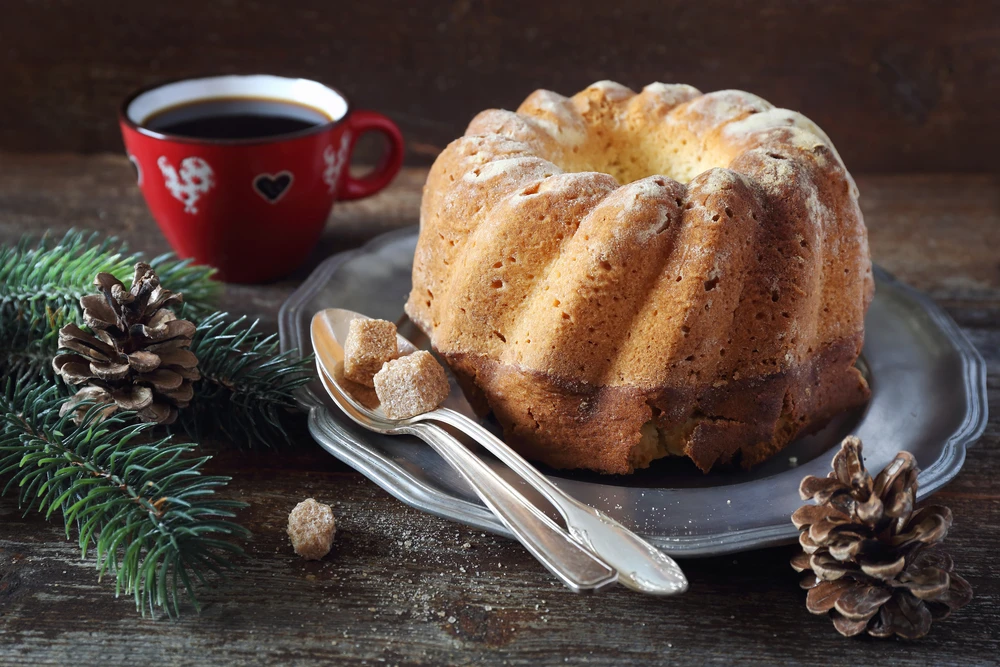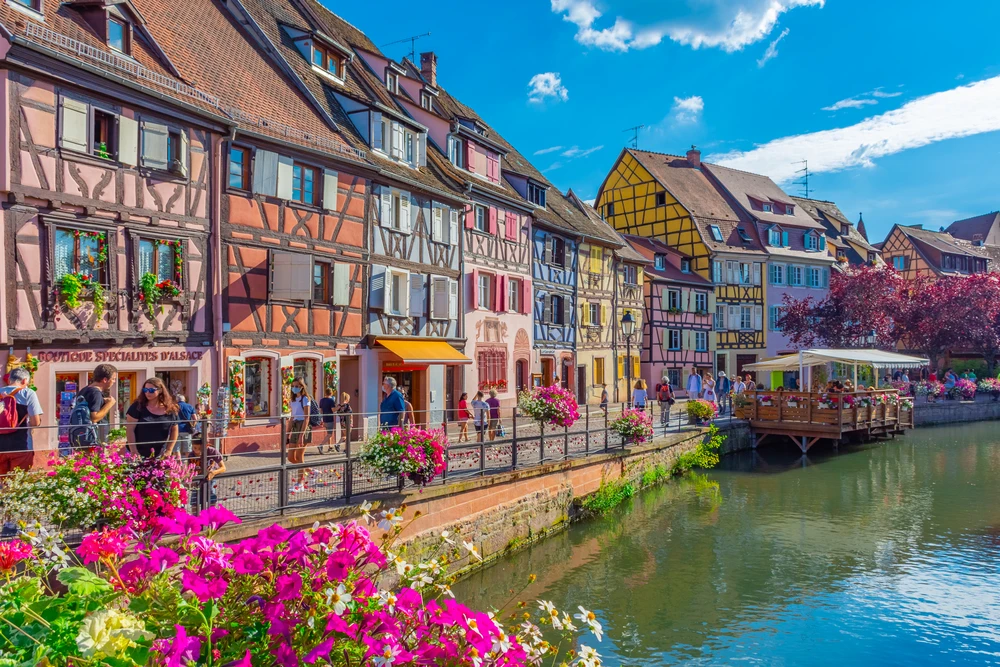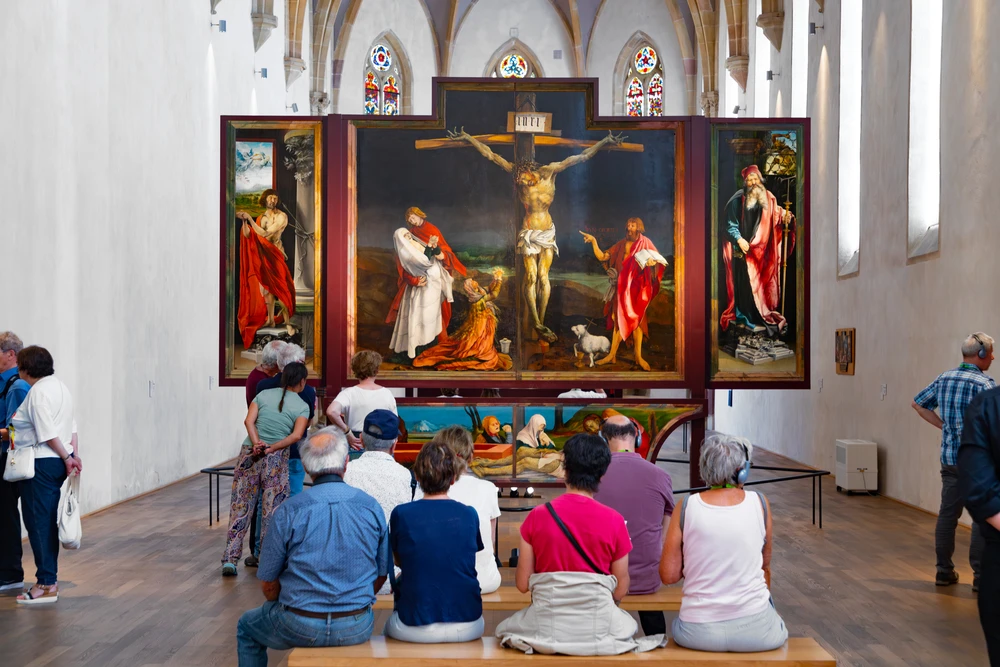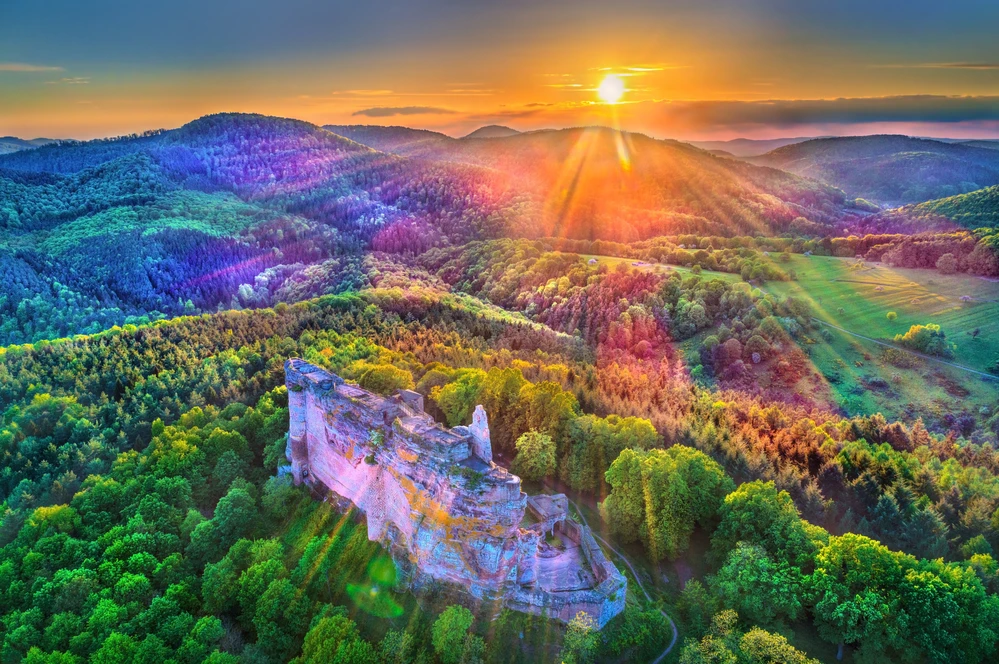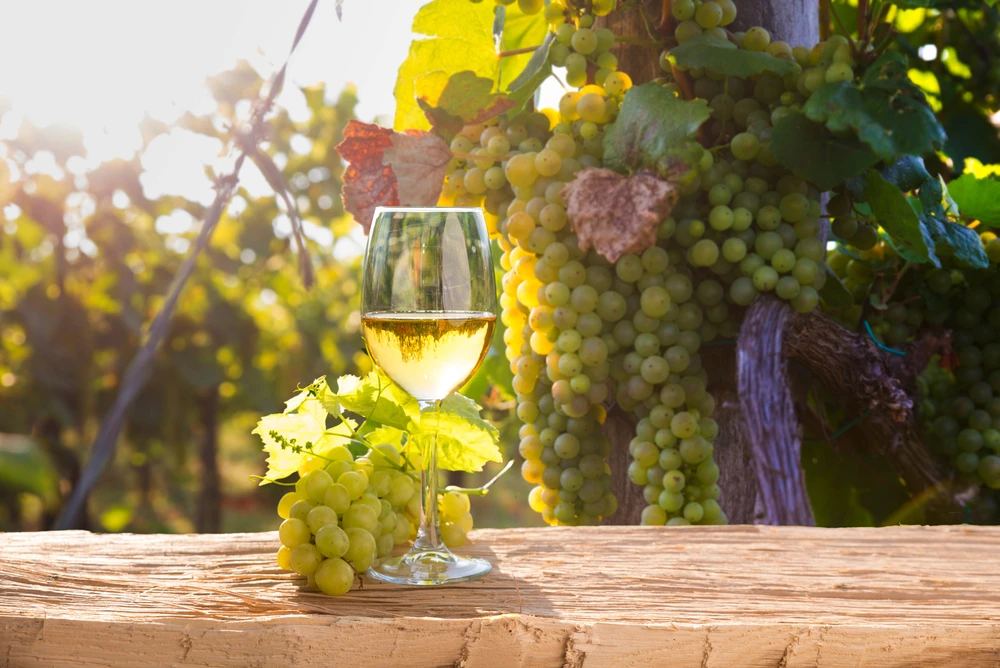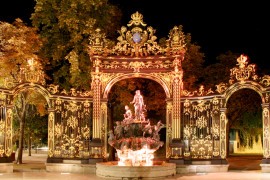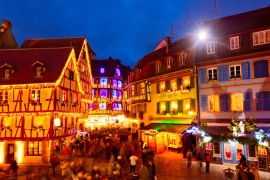The ranking you're about to discover is completely subjective, and that's okay. We've included other reasons to go to Alsace to give you a good overview, but nothing will ever replace your own experience and, above all, the advice of Alsatians who know their region so well, and who also know how to share it with those who are curious to get to know it.
The 7 wonders of Alsace
1 Strasbourg Cathedral
The façade of Strasbourg's Notre Dame Cathedral. Photo chosen by monsieurdefrance.com: dbrnjhrj/ Depositphotos.com
It is listed as Number 1 because it is both a symbol for Strasbourg and for Alsace. Its 142.22-metre spire, long the tallest structure in the world, has marked the Strasbourg landscape since its completion in 1439. Made of pink sandstone, which gives it its distinctive color, Strasbourg's Notre-Dame Cathedral was built between the 12th and 15th centuries, and is emblematic of the Gothic style .
The astronomical clock and the pillar of angels in Strasbourg cathedral. Photo chosen by monsieurdefrance.com: phb.cz / Depositphotos.Com
Of particular interest is the great portal, with its 14-meter-diameter rose depicting the Passion of Christ, and above it, between the two towers, the city of Strasbourg's belfry. Inside the cathedral, the baptismal font is entirely sculpted in the flamboyant Gothic style, as is the pulpit, designed by Hans Hammer between 1485 and 1487.Also worth seeing are the astonishing Angel Pillar, the large "Mount of Olives " sculpture created in 1498, the swallows' nest organ and, last but not least, the famous astronomical clock, whose automata are turned every hour, and some everyquarter-hourly, such as the child (1st quarter-hour), the young man (2nd quarter-hour), the mature man (3rd quarter-hour) and finally the old man (last quarter-hour).
The interior of Strasbourg's Notre Dame Cathedral with the organ. Photo chosen by monsieurdefrance.com: yorgy67 / Depositphotos.
Practical info :
Much of the tour is free. You can find opening times and prices here.
Address: Place de la Cathédrale. 67 000 STRASBOURG.
By streetcar: tramway lines A and D, Langstross Grand'Rue stop. By bus: line 10 (Corbeau stop), line 30 (Saint-Guillaume stop) or line 24 (ancienne douane stop).
2 Haut-Koënigsbourg and the castles of Alsace
With over 450 castles (in ruins or still standing), 150 of which are at altitude, Alsace is one of Europe's regions with the most ancient fortified castles. Often perched like eagles' nests, they punctuate the Alsatian landscape, and can be seen everywhere. Fleckenstein Castle rises to an altitude of 338 metres, and its ruins tell the story of Alsace to over 70,000 visitors a year. Lichtenberg Castle is also well worth a visit. Kaysersberg's schlossberg will dominate your visit to this one of Alsace's most beautiful towns (with its splendid Christmas market). But the most famous is the Château du Haut Koenigsbourg.
Hautkoenigsbourg castle in Alsace. Photo chosen by monsieurdefrance.com: Leonid_Andronov via depositphotos.com
In the heart of the Vosges mountains, at an altitude of 752 meters, Haut-Koënigsbourg castle is so high up that it can be seen from Colmar 25 km away on a clear day, and its roots go back to the 12th century. Made of pink sandstone, it has been repeatedly besieged, destroyed and rebuilt, notably during the terrible 30 Years' War. Purchased in a ruinous state by the Selestat commune in 1861, it was offered in 1899 to Kaiser Wilhelm II (Asace was German at the time, following the defeat of 1871), who decided to have it renovated. One might even say rebuild. The work was entrusted to Bodo Ebhardt, a young 35-year-old architect, who gave it the look he imagined it would have had around the year 1500. The Emperor followed the work closely, and the twentieth-century version of the château was inaugurated in 1908. Following the return of Alsace to France, the château became state property and attracts over 500,000 visitors every year.
To be seen nearby:
La volerie des aigles. A wildlife park specializing in birds of prey. Not far from Kintzeim Castle, you can discover shows and 30 species of birds of prey from all over the world.
Hautkoenigsbourg castle seen from below. Photo chosen by monsieurdefrance by Tristan MIMET from Pixabay
Practical info
Château du Haut-Koënigsbourg is located on the D159 in the commune of Orschwiller. Prices range from 4 to 9 euros (in 2023). Information on opening times and advance booking is available here.
To discover other castles (Lichtenberg, Fleckenstein...), take a look at this site.
3 Alsatian villages
Facades of the village of Eguisheim in Alsace. Photos chosen by monsieurdefrance: JeniFoto via depositphotos.com
With their typical stone (often sandstone) or timber-framed architecture, often colorful, full of architectural treasures, Alsace's villages are a festival of beauty, whether in summer when they are in bloom with geraniums, or in winter at the time of the Christmas markets so typical of Alsace. There are so many pretty villages to choose from, it's impossible to list them all, but here are a few of the most famous. In the midst of the vineyards, you'll discover Eguisheim, with its small-turreted town hall, colorful houses and former state courtyard. Riquewihr, with its octagonal castle, former château of the Wurtemberg family, rue de Gaulle, rue de la caserne...
Half-timbered houses on the Weiss river in Kaysersberg. Photo chosen by monsieurdefrance.com: makasanaphoto via dépositphotos.com
Not far away is Ribauvillé, dominated by the ruins of three castles, including the Château Saint Ulrich. Another must-see is Kaysersberg (meaning "the emperors' hill"), at the foot of the Schlossberg, with its fortified bridge and superb Renaissance town hall. And don't miss the UNESCO site of Neuf-Brisach , with its star-shaped ramparts designed by Vauban, Louis XIV's military architect, and listed as a World Heritage Site. You could also visit Hunspach, Turkheim (with its polychrome bell tower), Zellenberg or Mittelbergheim.
Practical info
The official Kaysersberg website
The official Ribauvillé and Riquewihr website
The official website of Eguisheim
A site with Alsatian villages and an interactive map. Very well done!
4 Alsatian gastronomy
If there's one gourmet region, it's Alsace. It's packed with culinary specialities to die for.
A good Alsatian sauerkraut. Photo chosen by monsieurdefrance: myviewpoint via dépositphotos.com
On the savoury side, of course, there's sauerkraut, the real thing. It's made with sauerkraut cabbage, bacon, kassler, smoked sausages and Strasbourg sausages. There's also choucroute de la mer, or three-fish sauerkraut, invented in 1972 by Guy-Pierre Bauman, owner of the Hammerzell house at the foot of Strasbourg cathedral. Three fish are used: halibut, salmon and haddock. Alsace is the home of baeckeoffe (cooked in special decorated terracotta dishes), in which pork, beef and lamb are served with potatoes. Alsace is the home of the famous pretzles, small or large, with coarse salt. Ideal for aperitifs! (They also come in a sweet version).
Spaëtles. Delicious with cream! Photo chosen by monsieurdefrance.com: PantherMediaSeller / via depositphotos.
You can also treat yourself to a flammenkueche, a thin, flambéed tart with lardons, cream, fromage blanc and onions. This is the land of the famous spaetzles, Alsatian pasta made with flour, eggs and butter, delicious in a pan or as an accompaniment to game. Last but not least, Alsace is home to the famous Munster, named after the town of Munster, a soft cow's milk cheese with a washed rind.
A kouglhopf, delicious at Christmas. Photo chosen by monsieurdefrance.com: photosimysia via dépositphotos.
For those with a sweet tooth, Alsace offers a myriad of delicacies such as kougelhof, a brioche with almonds and raisins, flavored with kirsch or rum (there's also a savory version with lardons). At Christmas, you'll be offered maneles and bredeles (although in the south, we say manala and bradala). Maneles are brioche buns in the shape of a little man, while bredeles are shortbread cakes that are baked in abundance at home and offered to neighbors. At Easter, we enjoy lamalas, a sponge cake in the shape of a lamb (paschal). And don't forget Alsatian tarts, especially the tarte au fromage blanc and the tarte alsacienne.
5 Colmar: Little Venice and the Musée Unterlinden
The city of Colmar and its colorful facades in Little Venice. Photo chosen by monsieurdefrance.com: dépositphotos.Com
Colmar is a magnificent and exciting city. First of all, a visit to "la petite venise" is a must. It's the Lauch River, which flows through Colmar, and its labyrinths form this typical district. At the beginning of the Krutenau, behind the Koïffus, towards the Place de l'Ancienne Douane, the Turenne and Saint Pierre bridges. Don't miss the Quai de la Poissonnerie. The Christmas season is particularly busy on the rue des Clefs, in the Grand-rue, the rue des marchands, or towards the place des six-montagnes-noires. Colmar is also home to the Musée Unterlinden, with its fabulous Issenheim Altarpiece (one of the 3,500 works on display), an area of almost 8,000 m2 that attracts almost 200,000 visitors a year.
In the Musée Unterlinden. Photo chosen by monsieurdefrance.com: Hackman via depositphotos.com
Practical info
Colmar is 550 kms from Paris, 3H00 by train. The Little Venice district is easy to find on your GPS phone by typing "quai de la poissonnerie". For the Musée Unterlinden, type "Place des Unterlinden". All the information (opening hours, prices...) is on the website , which is very well designed.
6 Vosges du Nord Nature Park
Fleckenstein castle in the Vosges du Nord Nature Park, surrounded by its national forest. Photo chosen by monsieurdefrance.Com: Leonid_Andronov via depositphotos.
A UNESCO biosphere reserve, the Vosges du Nord Nature Park also covers part of Lorraine (39 communes, including Bitche and Saint Louis Lès Bitche, home to the famous Saint Louis crystal glassworks). The Parc Naturel des Vosges du Nord covers 127,600 hectares, over 60% of which is forested. With its gentle mountains (the highest point, the Grand Wintersberg, rises to 581 meters above sea level), it offers more than 2,600 km of hiking trails (on foot, on horseback, by bike...), enabling visitors to discover 35 castles and 26 museums, as well as superb villages. It also boasts 8 Natura 2000 sites. In other words, if you love nature and greenery, this is the destination for you. It's a great place to take photos, even in autumn, one of the best seasons to discover it.
Practical info :
On a map look for 67 690 la Petite Pierre The official website is well done .
7 The wine route
Vineyards at Eguisheim. Photo chosen by monsieurdefrance.com: phb.cz via dépositphotos.com
It's the Alsatian must-have, since Alsace is obviously a land of vines. Many wines are produced here, including Pinot (black or white), Riesling (a rather dry white wine), Gewurztraminer (a white wine rich in sugar, exceptional in late harvest), Sylvaner (a lively dry white ideal for seafood), and Muscat, which is also excellent. Alsace's vineyards cover 15,600 hectares (mainly between Strasbourg in the north and Mulhouse in the south) and produce over 150,000,000 bottles a year... The wine route will take you across Alsace from top to bottom, discovering numerous villages (including those featured in the 3rd marvel) and, above all, wine tourism by discovering the cellars and products of Alsatian winemakers. A must-do on vacation, not just in summer, but also in spring.
Practical info :
This site lets you discover the wine route with an interactive map and cool info.
Alsace is much more than just the 7 wonders we've selected. The city of Strasbourg, for example, has twice been classified by UNESCO as a World Heritage Site. The Ill (Little France) district , which we love to stroll through in summer and in the heart of winter at the incredible Christmas market, but also the "Neustadt" district, a legacy of German annexation with typical late 19th-century architecture. We also love the bridges, the little restaurants... Colmar is magical, as are Selestat and Thann. Everywhere, especially in town, you can sample a wide range of Alsatian specialties, many of them very inexpensive, in the typical Alsatian vinstubs. Take the time to discover Alsace, and you'll be well rewarded.
Sorry for any mistranslations, but our translator has been on the Alsace wine trail twice, and visited quite a few wine cellars...

